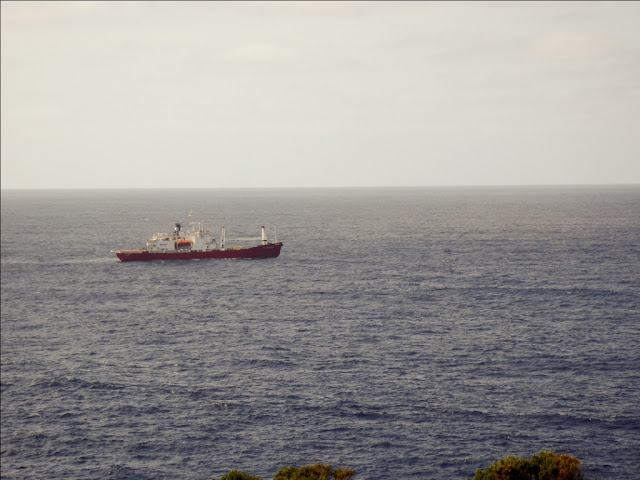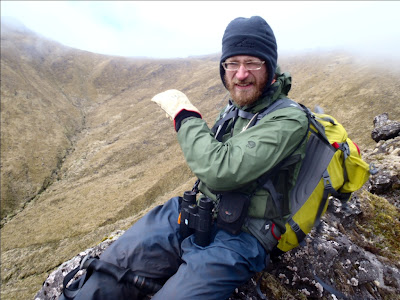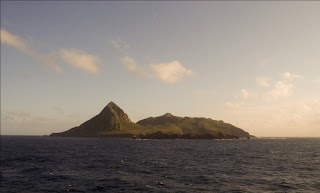 |
| Our first sight of the Agulhas |
Takeover was nothing like the pessimists predictions, in fact it was one of my best experiences on the island. Henk Louw, who was a biologist with Gough 54, came out to help train Karen and Sylvain, my replacements. He is great to work with, very knowledgeable and we get on really well. The best part has been having people to work with, rather than having to ask/beg the others to help me.
 |
| A lava "wave" behind Expedition Peak. It is about 50-75m high and several hundred meters long. |
Karen and Sylvain were thrown right in the deep end from the day that they arrived. We took them out to the Yellow Nosed study colony and started nest checks that very afternoon. The next day we were flown out to Waterfall Camp in the centre of the island and started the count of Tristan fledglings. Karen and I walked up the east coast, skirting Tarn Moss and Edinburgh Peak. We walked to Tavistock Crag and then turned west to walk between Barren Dome and Expedition Peak, then over the neck between Nigel’s Cap and Seahen Crag to Triple Peak and Giant Petrel Valley. We met up with Henk and Sylvain and then walked south past False Peak back to Waterfall Camp via the top of Edinburgh Peak.
 |
| Lava dykes on Green Hill near Gonydale |
We could have walked back to Waterfall Camp by contouring around Edinburgh Peak but because Henk had never been on top of it we decided to climb it. As we walked up it from the northern side, the mist became thicker and thicker and we lost sight of the top. Eventually we emerged on what I thought was the summit plateau until the mist parted for a moment and we saw that another steep climb lay ahead of us. Reluctantly the others followed me as I headed up this new climb, sure that the summit lay not far ahead. Once again we reached a plateau which I thought was the summit. I could have not been more wrong. I recognised none of the rocks and it seemed much larger than I remembered from our trip in April. Then once again, the mist parted and we saw that before us lay yet another climb, equal to the two before it. By this time Karen and Sylvain had lost all faith in my navigation skills, had taken out their GPS and were walking back to the camp by the most direct route possible. What they did not know is that the southern slopes of Edinburgh Peak are cut though by an encircling rock band which varies between three and ten metres in height. There is one gap in the rock band which is directly south of the summit and you have to cross the summit to get to it. The direct line that they were on does not pass through this gap. Despite our attempts to tell them this they were resolute. Then they came to the rock band… After much shouting to them, I managed to convince them that I was not a complete idiot and they walked up to join Henk and I on the summit. We made it back to the campsite just as the last of the dusk faded into night. Karen was finished and Sylvain was close to the same state. It was a harsh introduction to the realities of island walking and weather for them but one the whole it was good for them to learn early on that you cannot take the weather for granted and even familiar places can become very different in the mist.
 |
| The Agulhas from Gonydale |
The next day we walked back to Gonydale in the mist, taking advantage of the few gaps to count the last remaining count areas. Once we were in Gonydale the mists cleared and we told Karen and Sylvain that we had to ring all the fledgling Tristan Albatrosses in Gonydale. Their faces showed that this was not the greatest idea that they had ever heard and they would rather have spent the rest of the day relaxing. To their credit however they sucked it up and soldiered on. Sylvain quickly learned about the pungency of albatross chick vomit because the chick’s last resort defense is to vomit on you. The sensation of warm vomit running down your sleeve into your glove is one not soon forgotten.
 |
| The Bell 212 cargo slinging containers to the base |
They soon learned that squandering good weather days is not something that you should ever do on Gough. The next day dawned, cold, wet and windy and they were very grateful that we had finished all the work the previous day and had nothing more to do than just walk back to base.
 |
| The Agulhas at anchor |
To their credit they never complained or moaned, just accepted it stoically. They really did well in their first few days which if I remember my introduction to island walking must have been incredibly difficult. I was actually quite proud of them.
 |
| Brendan and Henk weighing a seal pup |
The next few days passed in a blur of work. We took them to the Rockhopper colony, did the Moorhen counts, checked the Yellownosed Albatross study and control colonies, ringed the remaining Tristan Albatross chicks on the Hummocks and at Tafelkoppie. Sylvain visited the Giant Petrel colony while I taught Karen to burrowscope and take samples from Skuas and Rockhoppers. we also had to assist with the checking of the containers from the Agulhas to make sure that no insects were imported on the island, as well as the monumental task of moving a years worth of food and supplies from the containers and into the food store or into the freezers.
 |
| Jan, one of the rope access guys hired to help with clearing Sagina. He came with me to complete the Tristan Albatross fledgling count. |
Henk, Brendan (one of the new weather observers with G57) and I weighed seal pups for Prof. Bester, which was quite an exciting task. You have to grab them by their rear flipper and slip a noose over their "ankle" so that they can be weighed on a spring balance. Holding a 10-20kg seal pup with your arms straight out and level is a very tiring task and if you get it wrong the seal can swing around and bite your legs which would be quite serious.
 |
| The Seal Beach river after two days of rain. We had to rig a Tyrolean Traverse to allow John Cooper and the others to cross safely. |
Henk, Michelle and I also visited the Glen, Capsize Sand and Long Beach to inventory the site of the old base, count penguins, elephant seals, giant petrels and litter. It was a repeat of our previous trip to the Glen with the power boat from the Edinburgh, except that we used a rubber duck from the Agulhas but we still had to swim ashore and back to the boat several times because the sea was too rough for them to bring it in close. Swimming with a full pack, clothes and gumboots in bitterly cold (~8 degree) water was ... interesting. Especially as the surf was breaking quite heavily. Nevertheless we made it safely ashore and back to the boat each time. By the time it came to check the final beach, Long Beach, we were all three frozen and shivering and we decided that the remainder of the survey could better be completed from the boat and that we did not need to swim again. We returned to the Agulhas were we were jokingly told that we would not be allowed to return to the island but would have to stay on board. It was only after Michelle and I threatened to swim back that they told us it was just a joke.
 |
| My first fruit in eleven months |
The whole fifteen days of takeover passed so, so, so fast. Before I knew what had hit me it was the takeover party and the official handover of my duties to Karen and Sylvain. The hand over ceremony was nice, each member of the team formally signs over their duties to their replacement and then we exchange T-shirts with the team's badge. DEA gave us all a rather weird present, a calculator come desk clock come photo holder... Thanks DEA. Then we partied hard and long into the small hours of the morning. A night to remember!
 |
| Juvenile male elephant seal, only four meters long |
We were due to leave Tuesday morning early so on Monday I took some time visit some of my favourite places for the last time and make sure that I said goodbye properly to this wondrous, amazing, incredible, special and unique island. Saying goodbye to Gough was one of the hardest and saddest things that I have have ever had to do. It is difficult to convey in words the depth and strength of attachment that I have developed for that tiny, insignificant little speck of land jutting out of the incredible vastness of the Atlantic Ocean. Leaving South Africa was easier knowing that you will be able to return to friends and family but leaving a place that you are fairly certain you will never ever return to is so much harder.
Sitting in my favourite spot, sheltered from the wind under the Phylica trees over looking the bay at Admirals, watching the Sooty Albatrosses turn and wheel overhead, with the barks of the seals echoing and the buntings chirping was a very emotional moment. I'm quite glad that no one else was there to see me cry.
 |
| A proud Rockhopper penguin with its egg |
Tuesday morning dawned, we packed all our bags into containers to be cargo slung to the Agulhas but it seems that Titan Helicopters are all water soluble and can't fly if it is drizzling. So we sat there, all dressed up and no place to go. We could not even really leave the immediate area of the base in case the weather cleared and the helicopters could fly. Eventually there was a brief gap and they managed to fly off all the remaining cargo containers. Before they could fly off the luggage the rain started again and they fled to the safety of the Agulhas before their helicopter started to become soggy.
 |
| The last time that the Agulhas will ever visit Gough, see through Archway Rock at the Glen |
So there we sat, hoping that the weather would improve. It did not. Eventually at about 1700 we collected our luggage and returned to our rooms. Tuesday night was rather subdued as people pondered the possible implications of a late arrival in the Cape and all the associated problems of changing flights and arrangements for family members to take leave so that they could meet the Agulhas as she docked. The weather on Wednesday was no better but we repacked our luggage into the containers, more in hope than in certainty. Thankfully at around 1500, the skies cleared and the helicopter arrived to take of the first group. Gough 56 was the last group to be flown off and we were all a little teary eyed as we stepped off Gough soil for the last time.
 |
| Henk, me and Michelle at the Glen |
The waiting to leave was the worst, to have decided that today is your last day and then to have it postponed was awful. You have readied yourself and then have to to do it all again, that really was unpleasant.
 |
| Gough 56 (front) and Gough 57 (back) |
The voyage back was wonderful, I was not seasick at all, just felt a little "off" on the first day but nothing worse. Sadly their was a heavy swell coming from the South west so we were not able to sail along the West coast of Gough and took the familiar route up the East coast past the Glen and Church Rock before sailing North west for Inaccessible Island. The best part of the voyage back was the food, endless plates of salad and fruit. The rapturous expressions on the face of all the faces of Gough 56 as they ate fresh fruit and veggies for the first time in thirteen months must have been a memorable sight!
 |
| The Base from the Agulhas |
We reached Inaccessible Island late the following day, with just enough light for the helicopter to fly and collect Peter, Martin and Martim who had been dropped there three weeks earlier to primarily do research on the endemic buntings. Then it was onwards to Tristan.
 |
| Church Rock and Lot's Wife on the north eastern corner of Gough |
 |
| Northern coast of Gough |
 |
| The first time I have seen the sun set into the sea since the 13th of December |
We arrived at Tristan under sullen grey clouds and a strengthening wind which made the harbour unusable. There were no more flight hours available for the helicopters and it looked like we were certain to be delayed at great cost. It costs DEA R250 000 per day to hire the crew for the Agulhas and there would be further charges at Cape Town if we missed our booked docking time. There was a flurry of phone calls between the ship, Tristan and South Africa trying to convince the DEA brass that it would be more sensible to pay R40 000 for the helicopter to fly the passengers and cargo off Tristan than it would be to be delayed for up to 48 hours and incur costs of more than R500 000. Eventually they came to their senses and the helicopter (which now was no longer water soluble) took off and collected all the passengers from Tristan. They even managed to take the members of Gough 56 who had not had the chance to visit Tristan before on to the island so that they could buy some souvenirs and see meet the islanders who had been so kind and generous to us during our year on Gough.
 |
| Nightingale Island |
 |
| Inaccessible Island |
 |
| The members of Gough 56 finally on Tristan |
 |
| The Settlement/Edinburgh-of-the-Seven Seas on Tristan |
And then we were off, Tristan was a fading speck in our wake and 3000 kilometers of Atlantic Ocean lay between us and home. The remainder of the voyage passed slowly with the only real things to look forward to being the next meal or game of hakkie sac on the Heli-deck. We did have a very memorable game of "ship-rules" volleyball down in the forward hold. The crew had carefully packed the containers to leave a area large enough for a volleyball court. Several great games between catering crew, ships crew and the passengers were played. Initially we lost horribly (we did not get more than ten points in our first five games) but we recovered and with a couple of new players we won several games. Great fun!
 |
| Lenticellular (Island) clouds over Tristan |
 |
| Volleyball in the hold |
 |
| One of the Agulhas's engines, together they produce 4473hp. |
We saw birds, dolphins and two ships on our voyage but sadly no whales. On Wednesday night about 2200 the lights of Cape Town were visible as a glow and the familiar shape of the Twelve Apostles and Lions Head slowly rose above the horizon. Finally seeing all the lights and the mountains after spending some much time thinking about that moment when we were on the island was wonderful. Seeing it again was almost like seeing it for the first time, a truly special moment. At about 0200 we anchored off Robben Island to await dawn and the pilot boat.
Everyone got up early the next morning to see the sunrise and to be on deck as we sailed in. The weather had once final trick to play on us. We went out side and could not see more than twenty meters in any direction. A thick bank of fog had descended and we we stuck in it. We could not move until the fog cleared and the harbour pilot came aboard. We eventually docked to rapturous applause at about 1100. There was a short ceremony to mark our return and the South African Weather Service thanked everyone on the team (except me, seriously! I though it was hilarious!) and then we were reunited with our families. It was incredible to see everyone again after such a long separation.
I collected my bags, said a sad goodbye to the members of the team most of whom I will probably not see again and climbed into the car with my dad and went home.























